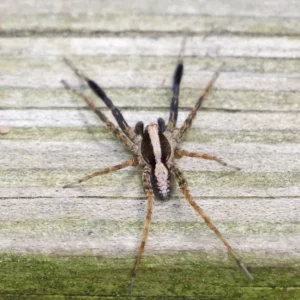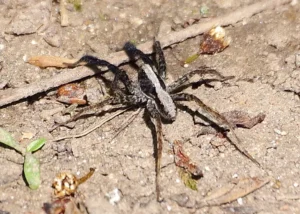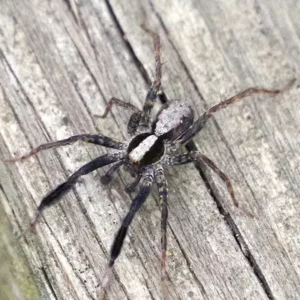Note: All links below are to external sites.
Greetings, BugFans,
The BugLady encountered this distinctive wolf spider (family Lycosidae) recently at Spruce Lake Bog, and then discovered some earlier shots of it from Riveredge in her “X-Files.” She figured that the furry-legged spider was in the genus Schizocosa. One source says that they look like they’re wearing leg-warmers. Some species in the genus have tufted legs and some don’t, and in those species that do, only the males have them. BugFan Mike suggested that it might possibly be the very common Schizocosa ocreata, the Brush-legged wolf spider. The BLWS has apparently been adopted by researchers, and there’s lots information about it online!
This spider is found on the ground in forests, forest edges, and grassland edges, where its longitudinal stripe camouflages it on leaf litter when viewed from above (as long as it’s sitting still). But research shows that when viewed from the side at ground level, the spiders contrast with their background rather than blending in, and so are easily seen by potential mates, especially when a male is waving his brushy limbs. Females are about one-fifth to one-quarter of an inch long (excluding legs), and males are slightly smaller. They have great eyesight but no ears, though they have sensory organs in their legs that pick up vibrations.

Wolf spiders don’t spin trap webs—they wander around ambushing other wolf spiders and small insects like crickets and springtails that they encounter on the ground, running out to capture them (like a wolf). They bite and immobilize small prey right away, but they envelop larger prey with their legs before biting them. Research shows that if a hunting spot proves to be unproductive, a BLWS will move to a different spot. They are preyed on by visual hunters like toads and birds. Spiders make up a huge proportion of the food that parent birds bring to their nestlings because spiders are rich in taurine, which is vital to brain development.
Wolf spiders don’t spin trap webs, so females are not waiting coyly in place for males to find them, but females do spin a pheromone-laced dragline that extends behind them as they move across the landscape. The dragline communicates, to any interested male that comes across it, her age, reproductive status, and even if she has cannibalized another spider recently. (One study suggests that the male can detect that a female has passed, and he can follow her scent trail, but he can’t tell which direction she was going.) He prefers well-fed virgins; she prefers larger males with bushier legs. Just sayin.’
Females communicate chemically, and males communicate visually by bouncing around and waving their legs vigorously. (OK, they’ve earned the nickname “the twerking spider.”) Males also communicate audibly/seismically by vibrating body parts against each other (stridulation) or against nearby objects or the substrate.
As always, spider courtship has its hazards. Female BLWSs, especially almost-mature and recently-molted females, commonly attempt to eat their suitors (sexual cannibalism). Smaller males with smaller leg tufts are cannibalized more frequently than larger males with larger leg tufts. Some species of male spiders bite reluctant females, and some bite and wrap females to immobilize them so they can make a safe getaway after the fact.* As researchers at the University of Cincinnati wrote, “antagonistic coevolution between the sexes often results in a complex arms race between male persistence and female resistance.” Male BLWSs may bite back if attacked, even though it may negatively affect their reproductive success.

Female wolf spiders carry their egg sac in the rear, attached to their spinnerets and raised so it doesn’t drag on the ground, controlling the temperature in the sac by moving into and out of the sunlight. (Nursery web spiders carry their egg sacs up front, in their jaws.) Her newly-hatched spiderlings ride around on her abdomen for a week or two until they can take care of themselves. The spiderlings overwinter as sub-adults and mature in spring and may live for a couple of years.
BLWSs react differently to wet and dry leaves. Whether they are displaying for a potential mate or just hunting, movement makes them conspicuous on the forest floor. One study showed that the call of a nearby Blue Jay causes them to “freeze” in place. Because vibrations travel effectively through dry leaves but are “muffled” by wet ones, they will freeze longer on dry leaves. Like the signals of Blue Jays, the courtship vibrations of male BLWSs travel better through dry leaves, so they resort to more leg-waving in wet weather. For the female, vibrations are a big part of the sales pitch, so male courtship isn’t as successful when leaves are damp.
Fun Facts About Brush-Legged Wolf Spiders
- They are known to prey on Black-legged/Deer ticks, which spread Lyme disease, effectively reducing tick populations in limited, outdoor experiments.
- It’s common for a BLWS to self-amputate and regenerate damaged limbs, but the regeneration process necessitates an extra few days between molts.
In love with wolf spiders? Here’s an interesting article called “Biologists say wolf spiders have a wider range of personality than once believed.”
The BugLady
*The BugLady has to be delicate about describing reproductive activities, because the filters of some servers and IT squads (some BugFans read BOTW where they work) bounce back anything they think is racy (like normal, biological terminology).
